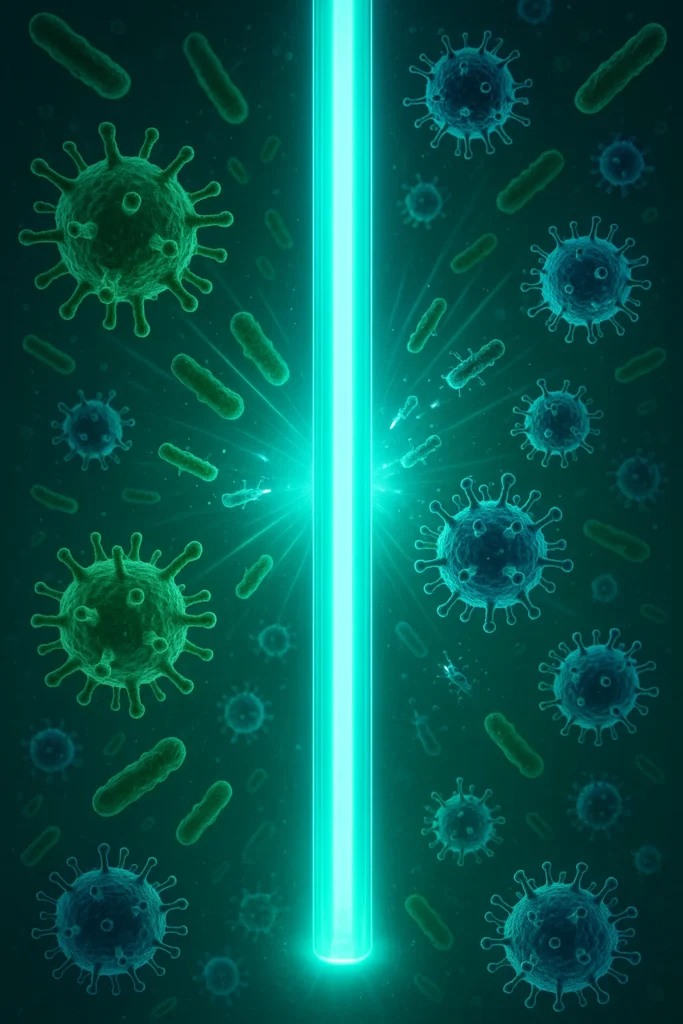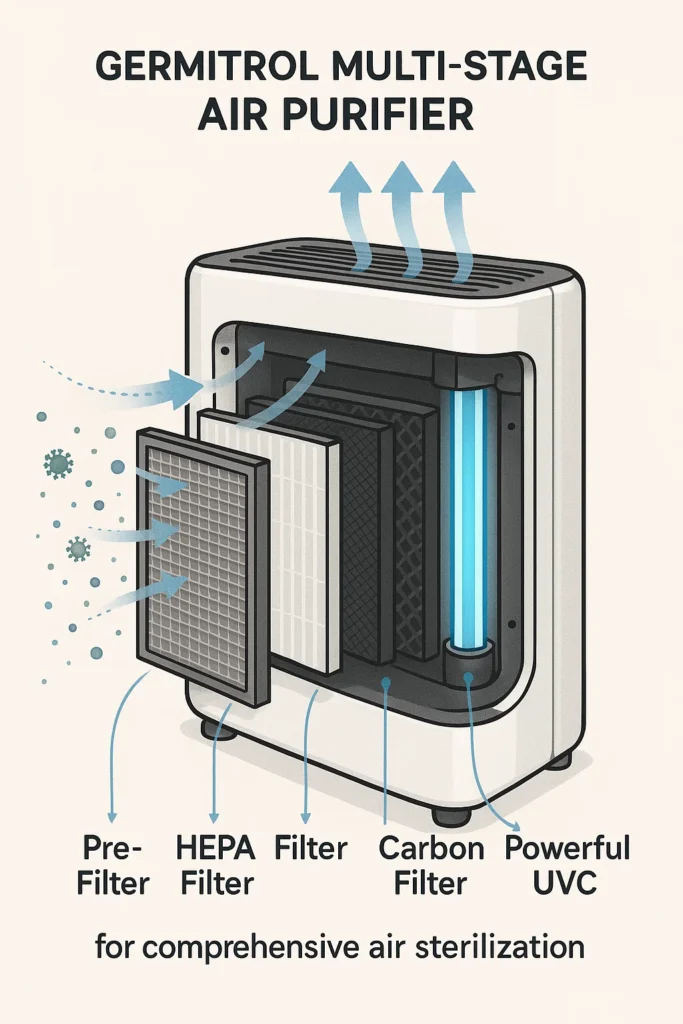Let’s face it: we’re spending more time indoors than ever, and suddenly, everyone’s an armchair expert on Indoor Air Quality (IAQ). But while we’re obsessing over visible dust bunnies, there’s an invisible battle raging in your air. And if you’ve been looking into air purifiers, you’ve probably stumbled into the great showdown: HEPA air purifiers versus UVC air purifiers. Which one’s the superhero, and which is just wearing a cape? Let’s dive in.
This article isn’t just going to break down the technical jargon; we’re going to expose why not all UVC air purifiers are created equal (spoiler: some are just glorified nightlights!). And ultimately, we’ll show you why a multi-layered approach isn’t just “nice to have”—it’s the real MVP for truly clean, healthy air.
The Filtration Foundation: Your Trusty HEPA Air Purifiers (They’re Good, But…)

HEPA filters. Ah, the unsung heroes of clean air, working silently behind the scenes. Born from a wartime secret, these guys are like microscopic sieves, trapping airborne nasties with impressive dedication.
How HEPA Works its Magic: Imagine a spiderweb, but for invisible particles. HEPA filters are a dense tangle of fibers that basically play “catch the particle” using three clever moves:
- Interception: Bigger particles just smack right into the fibers and stick. Boom, you’re trapped!
- Impaction: Medium-sized particles, trying to navigate the filter’s maze, lose control, crash, and get stuck. Sorry, buddy, no escape!
- Diffusion: The truly tiny, erratic particles (we’re talking micro-ninja dust here) bounce around randomly until they inevitably collide with a fiber and get caught. Game over!
What HEPA Air Purifiers Excel At (and Why We Still Love Them):
- Particle Patrol: These champions grab 99.97% of particles as tiny as 0.3 microns. We’re talking dust, pollen, pet dander, those annoying smoke particles, and even mold spores (they’ll hold onto them tightly!).
- Allergy & Asthma Relief: If you’re constantly sniffing or wheezing, a HEPA air purifier can be a true lifesaver, making your indoor space a much friendlier place to breathe.
- Basic Cleanliness: They lay the groundwork for clean air by simply removing physical pollutants. Think of them as your first line of defense.
HEPA’s Hidden Limitations (The Plot Twist):
As much as we adore HEPA, they have a few secrets they’d rather keep quiet:
- They Don’t Kill Germs (Awkward!): This is the big one. A HEPA air purifier is a fantastic catcher, but it’s not a killer. Viruses, bacteria, mold spores? They’re alive and well, just chilling on the filter. If that filter gets disturbed or isn’t changed often enough, those microscopic squatters could potentially stage a comeback!
- Odors & VOCs? Nope! HEPA filters are particle specialists, not odor or chemical sniffers. Those lingering cooking smells, pet odors, or sneaky VOCs from new furniture? HEPA’s letting them pass right through unless there’s an activated carbon filter tag-teaming with it.
- Maintenance Mayhem: Like any good trap, it eventually gets full. Filters clog, efficiency drops, and you’re buying replacements. Forget to swap them out? Your “purifier” could become a grumpy, less effective air blocker.
- Sneaky Air (Bypass): If the filter isn’t perfectly sealed, some crafty air might just sneak around it, completely bypassing the “clean” process. Tsk tsk.
The Germicidal Edge: Understanding UVC Air Purifiers (The Real Sterilizers!)

Now, let’s talk about the heavy hitter in germ warfare: the UVC air purifier. Forget trapping; these bad boys go straight for the kill (or, more precisely, the inactivation). This is why calling them “air sterilizers” isn’t just fancy talk – it’s science!
How UVC Works its Germ-Killing Magic (It’s Molecular Mayhem!): Imagine a tiny, invisible ray gun. UVC light (specifically the wavelengths around 254 nanometers) blasts microorganisms, messing with their DNA and RNA. Think of it as scrambling their instruction manual. Once their genetic code is scrambled, they can’t reproduce, they can’t function, and they can’t make you sick. Poof! Effectively, they’re sterilized.
What UVC Air Purifiers Excel At (The Superpowers):
- Microbial Assassination: Viruses (yes, those ones), bacteria, mold spores, fungi – a good UVC air purifier zaps ’em all. This is your proactive defense against airborne biological threats.
- No “Full” Filter: Since it’s light doing the work, there’s no physical filter getting saturated with live germs. The UVC light is continuously doing its thing.
- Biofilm Busting (Especially in HVAC): This is huge. For those hidden HVAC coils that love to grow slimy biofilms (a gross mix of mold and bacteria), integrated UVC can continuously irradiate them, keeping those nasty breeding grounds sterile and your system running cleaner.
The Crucial Differentiator: Not All UVC Air Purifiers Are Created Equal – The “Don’t Be Fooled!” Alert!
Okay, deep breath. This is the part where we get serious because it’s where many brands try to pull a fast one. Simply having a “UVC light” in an air purifier is NOT enough. Seriously, some are about as effective as a nightlight in a disco.
The secret sauce to a truly effective UVC air purifier is the UVC output (or dosage). It’s all about giving those tiny invaders enough light to really mess them up. Think of it like a medical procedure: you need the right dose of medicine for it to work. For UVC, it depends on:
- UVC Lamp Intensity (The Oomph!): This is the power behind the light. A wimpy lamp means wimpy germicidal action. You need high intensity to make a real difference, especially with fast-moving air.
- Exposure Time (The “Hang Time”): How long are those nasty microbes actually bathed in UVC light? If the air blasts past too quickly, even a strong lamp won’t get the job done. The purifier’s design matters!
- Lamp Placement & Design: Is the light actually hitting what it’s supposed to? Optimal placement ensures comprehensive coverage.
If any of these factors are weak, those microorganisms are just getting a tan, not getting inactivated. A low-output UVC air purifier is often just fancy marketing, giving you a false sense of security. At Germitrol, we’re proud to say we design our UVC air purifiers for true, verifiable germicidal efficacy – because real results matter, not just glowing purple bulbs.
The Unbeatable Combination: Why Germitrol Integrates Both (And The Whole Squad!)

So, is it a HEPA fan club, or a UVC rave? Why choose when you can have a full-blown air purification symphony?
HEPA and UVC aren’t rivals; they’re the ultimate tag team.
- HEPA handles the visible stuff: The dust bunnies, the pollen clouds, the pet dander fluff.
- UVC tackles the invisible, living threats: Viruses, bacteria, mold spores that are too small or resilient for just a filter.
Germitrol takes this dynamic duo and adds an entire squad of filtration layers:
- Pre-Filters: Your first line of defense, catching the big stuff and saving your more expensive filters. Smart!
- HEPA Filtration: Our certified HEPA filters grab 99.97% of those tiny particles, ensuring excellent particulate removal.
- Activated Carbon Filters: These guys are the unsung heroes for smells! They gobble up gaseous pollutants like VOCs (hello, new carpet smell!), cooking odors, and pet funk that neither HEPA nor UVC alone can touch.
- High-Output UVC Sterilization: Our meticulously engineered UVC lamps aren’t messing around. They deliver the precise intensity and exposure time needed to inactivate airborne viruses, bacteria, and mold, turning your UVC air purifier into a bona fide air sterilizer.
- Post-Filters (the cherry on top!): Some systems include a final filter for that extra polish before the air hits your lungs.
The result of this comprehensive approach? Your indoor air isn’t just “less dusty.” It’s actively sterilized of biological contaminants, purified of odors and VOCs, and simply pristine.
Choosing Your Air Defender: When and Why to Prioritize (or Go All-In!)
So, how do you pick your air champion?
- For “Just the Basics”: If your main concern is strictly dust and allergens in a low-risk spot, a standalone HEPA air purifier might be okay. But be mindful of what it doesn’t do.
- For Next-Level Health Protection & Peace of Mind (Where Germitrol Shines, obviously!):
- High-Traffic Zones: Offices, clinics, schools, retail – anywhere people gather and germs mingle.
- Illness Concerns: If you’re serious about reducing the spread of airborne bugs (colds, flu, the works).
- Mold & Odor Woes: Battling musty smells or chemical odors.
- Vulnerable Folks: Protecting kids, the elderly, or anyone with compromised immune systems.
- Investing in Wellness: For spaces where employee, client, or patient well-being isn’t just a buzzword, but a commitment.
And seriously, please don’t fall for those cheap “UVC air purifiers” that offer more show than go. Demand proof of efficacy! Look for systems like Germitrol’s that are built with robust UVC output and smart, integrated filtration.
Conclusion: The Future of Indoor Air is Smart, Comprehensive, and Truly Clean!
In the ever-evolving world of indoor air quality, picking just one technology is like bringing a spoon to a knife fight. While HEPA filters are essential for grabbing particles, the proactive power of UVC light to inactivate microorganisms is what truly elevates air purification to air sterilization.
Germitrol’s mission is to deliver these comprehensive, multi-stage air purification systems that cleverly combine the best of filtration with high-output UVC sterilization and advanced odor control. We’re not just about “cleaner” air; we’re about air that’s actively purified and sterilized for ultimate health, comfort, and, frankly, ultimate peace of mind.
Ready to Experience Truly Sterilized and Purified Air?
The invisible quality of your indoor air impacts everything. Don’t settle for partial solutions. Germitrol offers scientifically engineered UVC Air Purifiers designed to provide the highest level of air sterilization and purification.
Explore Germitrol’s UVC Air Purifiers https://www.germitrol.com/products.html
Request a Personalized Air Quality Consultation https://www.germitrol.com/contact.html

